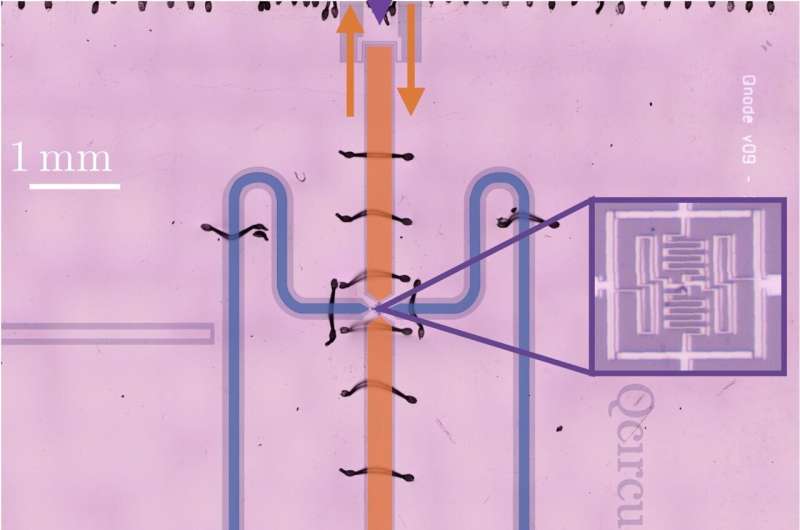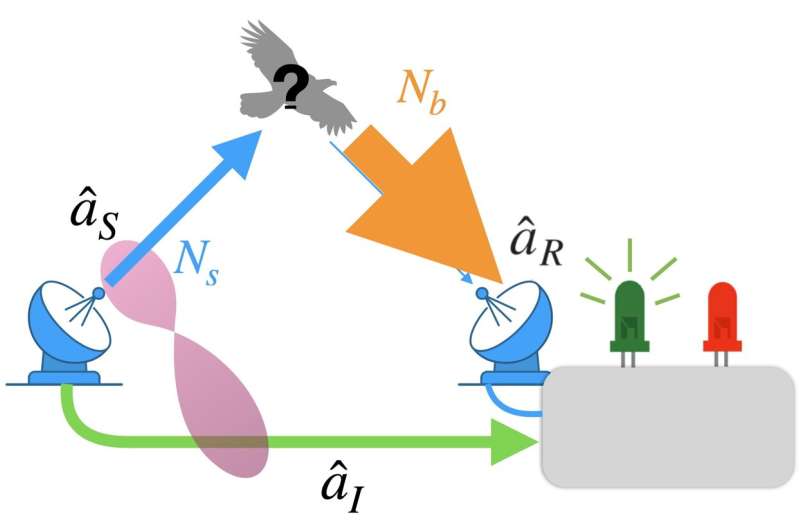July 20, 2023 feature
This article has been reviewed according to Science X's editorial process and policies. Editors have highlighted the following attributes while ensuring the content's credibility:
fact-checked
peer-reviewed publication
trusted source
proofread
A quantum radar that outperforms classical radar by 20%

Quantum technologies, a wide range of devices that operate by leveraging the principles of quantum mechanics, could significantly outperform classical devices on some tasks. Physicists and engineers worldwide have thus been working hard to achieve this long-sought "quantum advantage" over classical computing approaches.
A research team at Ecole Normale Supérieure de Lyon, CNRS recently developed a quantum radar that could significantly outperform all existing radars based on classical approaches. This new radar, introduced in a paper published in Nature Physics, concurrently measures an entangled probe and the idler microwave photon states occurring once this probe reflects from target objects, merging with thermal noise.
"We invented a superconducting circuit in 2020 that was able, among other things, to generate entanglement, store and manipulate microwave quantum states and count the number of photons in a microwave field," Benjamin Huard, one of the researchers who carried out the study, told Phys.org. "We then realized that it had all the features we needed to tackle one of the biggest challenges in microwave quantum metrology: demonstrating a quantum advantage in radar sensing."
Several past studies tried to develop quantum radars that outperformed conventional radars. This quantum advantage was eventually realized using optical systems, yet before this study it was not yet achieved using microwave radiation.
Huard and his colleagues are thus the first who developed a microwave-based quantum radar that performs significantly better than any classical radar technology reported to date. Their radar works by exploiting correlations imprinted between two microwave radiations beyond the bounds of classical physics theories.
"Our radar generates quantum entanglement between a microwave resonator and a signal that is emitted towards a target hidden by a lot of microwave noise such as in the atmosphere," Huard explained. "If the target actually exists, it will reflect a tiny bit of signal together with a lot of noise. Our device then combines this fraction of interesting signal with the field stored in the resonator in a way that produces more or less photons depending on whether the target exists or not. Finally, a built-in microwave photon counter probes these photons."

Past research showed that quantum correlations can make radar detection up to four times faster in scenarios with comparable signal power and target noise. In initial evaluations, the microwave quantum radar developed by the researchers sped up radar detection by 20% compared to classical radars.
"It was very hard to make this demonstration work despite the simplicity of the conditions of operation," Huard said. "We worked with a single unknown: the presence or absence of the target, and we did the whole experiment at 10 mK, far from open air. What I find most daunting for direct applications in quantum radars is that the scheme requires signals of much less than a microwave photon to observe a quantum advantage and we saw how much the initial signal must be purely entangled with the resonator to get anything useful."
Huard and his colleagues carried out a series of tests, where they measured the quantum advantage of their radar over a wide range of parameters. These tests revealed that the purity of the initial entangled state between the probe and idler in their device could be a limiting factor, which should be considered when implementing their radar in real-world settings.
"What I find most interesting is the fact that we can get a quantum advantage despite an environment that is so noisy that entanglement cannot survive," Huard said. "It is a rare example where beyond-classical correlations can be exploited to get an advantage without any remaining entanglement."
The recent work by this team of researchers greatly contributes to ongoing efforts aimed at improving the performance of quantum radar technology. In the future, the approach underpinning its functioning could inspire the development of similar microwave quantum radars that can achieve even greater quantum advantage.
"I believe that there are many more applications that are waiting to be discovered in which these non-classical, yet entanglement-free correlations play a role," Huard added. "We would now like to understand better how to perform microwave sensing using quantum resources, for instance in the context of electron spin resonance or axion research."
More information: R. Assouly et al, Quantum advantage in microwave quantum radar, Nature Physics (2023). DOI: 10.1038/s41567-023-02113-4.
Journal information: Nature Physics
© 2023 Science X Network





















